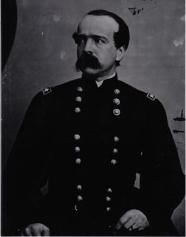
The melody is both eloquent and haunting and the history of its origin is interesting and somewhat clouded in controversy. In the British Army, a similar type call known as Last Post has been sounded over soldiers' graves since 1885, but the use of Taps is unique to the United States military, since the call is sounded at funerals, wreath-laying and memorial services. Taps began as a revision to the signal for Extinguish Lights (Lights Out) at the end of the day. Up until the Civil War, the infantry call for Extinguish Lights was the one set down in Silas Casey's (1801-1882) Tactics, which had been borrowed from the French. The music for Taps was adapted by Union General Daniel Butterfield for his brigade (Third Brigade, First Division, Fifth Army Corps, Army of the Potomac) in July, 1862.
Daniel Adams Butterfield (1831-1901) was born in
Utica, New York and graduated from Union College at Schenectady. He was the
eastern superintendent of the American Express Company in New York when the
Civil War broke out. A Colonel in the 12th Regiment of the New York State
Militia, he was promoted to Brigadier General and given command of a brigade of
the 5th Corps of the Army of the Potomac.

Daniel Butterfield
During the Peninsular Campaign Butterfield distinguished himself when, during the Battle of Gaines Mill and despite an injury, he seized the colours of the 83rd Pennsylvania and rallied the regiment at a critical time in the battle. He was awarded the Medal of Honor for that act of heroism.

Above: Brigade Flag of Butterfield's 3rd Brigade, 1st Division, 5th Corps, Army of the Potomac
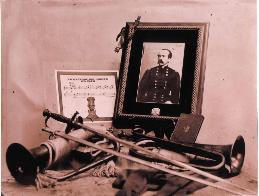
Above:
Items relating to Daniel
Butterfield - two bugles, Medal of Honor, his presentation
spurs from his officers, and his duty sword
As the story goes, General Butterfield was not pleased with the call for Extinguish Lights, feeling that the call was too formal to signal the days end, and with the help of the brigade bugler, Oliver Willcox Norton (1839-1920), wrote Taps to honor his men while in camp at Harrison?s Landing, Virginia, following the Seven Days battle. These battles took place during the Peninsular Campaign of 1862. The new call, sounded that night in July, 1862, soon spread to other units of the Union Army and was reportedly also used by the Confederates. Taps was made an official bugle call after the war.
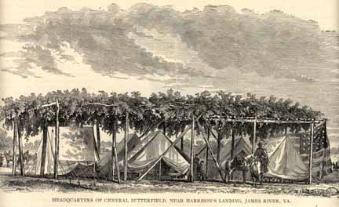
"Headquarters of General Butterfield, Near Harrison's Landing, James River, VA"
The highly romantic account of how Butterfield composed the call surfaced in 1898 following a magazine article written that summer. The August, 1898 issue of Century Magazine contained an article called "The Trumpet in Camp and Battle," by Gustav Kobbe, a music historian and critic. He was writing about the origin of bugle calls in the military and in reference to Taps, wrote:
"In speaking of our trumpet calls I purposely omitted one with which it seemed most appropriate to close this article, for it is the call which closes the soldier's day... Lights Out. I have not been able to trace this call to any other service. If it seems probable, it was original with Major Seymour, he has given our army the most beautiful of all trumpet-calls."
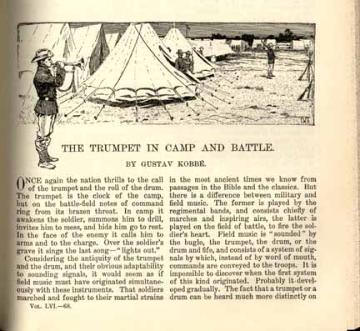
First page of "The Trumpet in Camp and Battle" by Gustav
Kobbe,
from the August 1898 Century magazine.
Kobbe was using as an authority the Army drill manual on infantry tactics prepared by Major General Emory Upton in 1867 (revised in 1874). The bugle calls in the manual were compiled by Major (later General) Truman Seymour of the 5th U.S. Artillery. Taps was called Extinguish Lights in these manuals since it was to replace the "Lights Out" call disliked by Butterfield. The title of the call was not changed until later, although other manuals started calling it Taps because most soldiers knew it by that name. Since Seymour was responsible for the music in the Army manual, Kobbe assumed that he had written the call. Kobbe's inability to find the origin of Extinguish Lights (Taps) prompted a letter from Oliver W. Norton in Chicago who claimed he knew how the call came about and that he was the first to perform it.
Norton wrote:
"Chicago, August 8, 1898
I was much interested in reading the article by Mr. Gustav Kobbe, on the Trumpet
and Bugle Calls, in the August Century. Mr. Kobbe says that he has been unable
to trace the origin of the call now used for Taps, or the Go to Sleep, as it is
generally called by the soldiers. As I am unable to give the origin of this
call, I think the following statement may be of interest to Mr. Kobbe and your
readers... During the early part of the Civil War I was bugler at the
Headquarters of Butterfield's Brigade, Morell's Division, Fitz-John Porter's
Corps, Army of the Potomac. Up to July, 1862, the Infantry call for Taps was
that set down in Casey's Tactics, which Mr. Kobbe says was borrowed from the
French.
One day, soon after the seven
days battles on the Peninsula, when the Army of the Potomac was lying in camp at
Harrison's Landing, General Daniel Butterfield, then commanding our Brigade,
sent for me, and showing me some notes on a staff written in pencil on the back
of an envelope, asked me to sound them on my bugle. I did this several times,
playing the music as written. He changed it somewhat, lengthening some notes and
shortening others, but retaining the melody as he first gave it to me. After
getting it to his satisfaction, he directed me to sound that call for Taps
thereafter in place of the regulation call. The music was beautiful on that
still summer night, and was heard far beyond the limits of our Brigade. The next
day I was visited by several buglers from neighboring Brigades, asking for
copies of the music which I gladly furnished. I think no general order was
issued from army headquarters authorizing the substitution of this for the
regulation call,
but as each brigade commander exercised his own discretion in such minor
matters, the call was gradually taken up through the Army of the Potomac. I have
been told that it was carried to the Western Armies by the 11th and 12th Corps,
when they went to Chattanooga in the fall of 1863, and rapidly made its way
through those armies. I did not presume to question General Butterfield at the
time, but from the manner in which the call was given to me, I have no doubt he
composed it in his tent at Harrison's Landing. I think General Butterfield is
living at Cold Spring, New York. If you think the matter of sufficient interest,
and care to write him on the subject, I have no doubt he will confirm my
statement."
-Oliver W. Norton
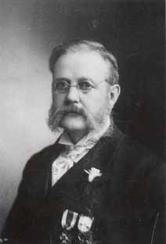
Oliver Willcox Norton
The editor did write to Butterfield as suggested by Norton. In answer to the inquiry from the editor of the Century, General Butterfield writing from Gragside, Cold Spring, on August 31, 1898 wrote:
"I recall, in my dim memory,
the substantial truth of the statement made by Norton, of the 83rd Pa., about
bugle calls. His letter gives the impression that I personally wrote the notes
for the call. The facts are, that at the time I could sound calls on the bugle
as a necessary part of military knowledge and instruction for an officer
commanding a regiment or brigade. I had acquired this as a regimental commander.
I had composed a call for my brigade, to precede any calls, indicating that such
were calls, or orders, for my brigade alone. This was of very
great use and effect on the march and in battle. It enabled me to cause my whole
command, at times, in march, covering over a mile on the road, all to halt
instantly, and lie down, and all arise and start at the same moment; to forward
in line of battle, simultaneously, in action and charge etc. It saves fatigue.
The men rather liked their call, and began to sing my name to it. It was three
notes and a catch. I can not write a note of music, but have gotten my wife to
write it from my whistling it to her, and enclose it. The men would sing, "Dan,
Dan, Dan, Butterfield, Butterfield" to the notes when a call came. Later, in
battle, or in some trying circumstances or an advance of difficulties, they
sometimes sang, "Damn, Damn, Damn, Butterfield, Butterfield."
The call of Taps did not seem to be as smooth, melodious and musical as it
should be, and I called in some one who could write music, and practiced a
change in the call of Taps until I had it suit my ear, and then, as Norton
writes, got it to my taste without being able to write music or knowing the
technical name of any note, but, simply by ear, arranged it as Norton describes.
I did not recall him in connection with it, but his story is substantially
correct. Will you do me the favor to send Norton a copy of this letter by your
typewriter? I have none."
-Daniel Butterfield

On the surface, this seems to
be the true history of the origin of Taps. Indeed, the many articles written
about Taps cite this story as the beginning of Butterfield's association with
the call. Certainly, Butterfield never went out of his way to claim credit for
its composition and it wasn't until the
Century article that the origin came to light.
There are however, significant differences in Butterfield's and Norton's
stories. Norton says that the music given to him by Butterfield that night was
written down on an envelope while Butterfield wrote that he could not read or
write music! Also Butterfield's words seem to suggest that he was not composing
a melody in Norton's presence, but actually arranging or revising an existing
one. As a commander of a brigade, he knew of the bugle calls needed to relay
troop commands. All officers of the time were required to know the calls and
were expected to be able to play the bugle. Butterfield was no different - he
could sound the bugle but could not read music. As a colonel of the 12th NY
Regiment, before the war, he had ordered his men to be thoroughly familiar with
calls and drills.
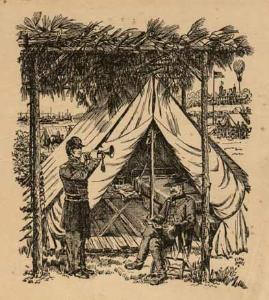
Oliver Willcox Norton and General Butterfield at
Harrison's Landing, July 1862
What could account for the variation in stories? My research shows that Butterfield did not compose Taps but actually revised an earlier bugle call. The fact is that Taps existed in an early version of the call Tattoo. As a signal for end of the day, armies have used Tattoo to signal troops to prepare them for bedtime roll call. The call was used to notify the soldiers to cease the evening's drinking and return to their garrisons. It was sounded an hour before the final call of the day to extinguish all fires and lights. This early version is found in three manuals - the Winfield Scott (1786-1866) manual of 1835, the Samuel Cooper (1798-1876) manual of 1836 and the William Gilham (1819?-1872) manual of 1861. This call, referred to as the Scott Tattoo, was in use from 1835-1860. A second version of Tattoo came into use just before the Civil War and was in use throughout the war replacing the Scott Tattoo.
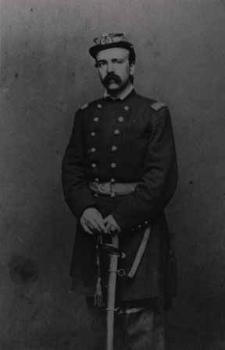
Butterfield as a Colonel in the 12th New York
Militia Regiment

The 1835 (Scott) Tattoo
The fact that Norton says that
Butterfield composed Taps cannot be questioned. He was relaying the facts as he
remembered them. His conclusion that Butterfield wrote Taps can be explained by
the presence of the second Tattoo. It was most likely that the second Tattoo,
followed by Extinguish Lights (the first eight measures of today's Tattoo), was
sounded by Norton during the course of the war.
It seems possible that these two calls were sounded to end the soldier's day on
both sides during the war. It must therefore be evident that Norton did not know
the early Tattoo or he would have immediately recognized it that evening in
Butterfield's tent. If you review the events of that evening, Norton came into
Butterfield's tent and played notes that were already written down on an
envelope. Then Butterfield,
"changed it somewhat, lengthening some notes and shortening others, but
retaining the melody as he first gave it to me." If you compare that statement while
looking at the present day Taps, you will see that this is exactly what happened
to turn the early (Scott) Tattoo into Taps.
Butterfield, as stated above, was a Colonel before the War and in General Order
No. 1 issued by him on December 7, 1859 had the order: "The Officers and non-commissioned Officers are expected to be
thoroughly familiar with the first thirty pages, Vol. 1, Scott's
Tactics, and ready to answer any questions in regard to the same previous to
the drill above ordered." Scott's
Tactics include the bugle calls that Butterfield must have known and used. If
Butterfield was using Scott's Tactics
for drills, then it is feasible that he would have used the calls as set in the
manual.
Lastly, it is hard to believe that Butterfield could have composed anything that
July in the aftermath of the Seven Days battles which saw the Union Army of the
Potomac mangled by Lee's Army of Northern Virginia. Over twenty six thousand
casualties were suffered on both sides. Butterfield had lost over 600 of his men
on June 27th at the battle of Gaines Mill and had himself been wounded. In the
midst of the heat, humidity, mud, mosquitoes, dysentery, typhoid and general
wretchedness of camp life in that early July, it is hard to imagine being able
to write anything.
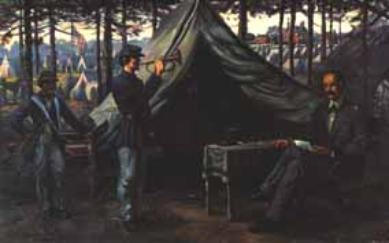
Butterfield and Norton, as depicted by Sidney King
In the interest of historical accuracy, it should be noted that General Butterfield did not compose Taps, rather that he revised an earlier call into the present day bugle call we know as Taps. This is not meant to take credit away from him.
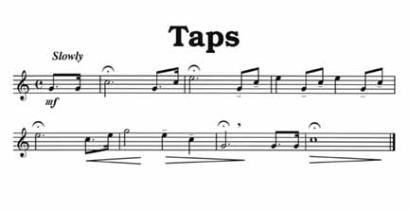
Following the Peninsular
Campaign, Butterfield served at 2nd Bull Run, Antietam and at Marye's Heights in
the Battle of Fredericksburg. Through political connections and his ability for
administration, he was promoted to Major General and served as Chief of Staff of
the Union Army of the Potomac under Generals Joseph Hooker and George Meade. He
was wounded at Gettysburg and then reassigned to the Western Theater. By war's
end, he was breveted a Brigadier General and stayed in the army after the Civil
War, serving as superintendent of the army's recruiting service in New York City
and Colonel of the 5th Infantry. In 1870, after resigning from the military,
Butterfield went back to work with the American Express Company. He was in
charge of a number of special public ceremonies, including General William
Tecumseh Sherman's funeral in 1891.
Butterfield died in 1901. His tomb is the most ornate in the cemetery at West
Point despite the fact that he never attended. There is also a monument to
Butterfield in New York City near Grant's Tomb. There is nothing on either
monument that mentions Taps or Butterfield's association with the call. Taps was
sounded at his funeral.
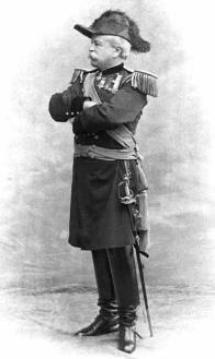
General Butterfield in the 1890s
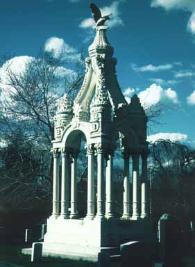
The Butterfield grave at West Point, NY
How did the call become
associated with funerals? The earliest official reference to the mandatory use
of Taps at military funeral ceremonies is found in the U.S. Army Infantry Drill
Regulations for 1891, although it had doubtless been used unofficially long
before that time, under its former designation Extinguish Lights.
The first sounding of Taps at a military funeral is commemorated in a stained
glass window at The Chapel of the Centurion (The Old Post Chapel) at Fort
Monroe, Virginia.
The site where Taps was born is also commemorated by a monument located on the
grounds of Berkeley Plantation, Virginia. This monument to Taps was erected by
the Virginia American Legion and dedicated on July 4, 1969. The site is also
rich in history, for the Harrisons of Berkeley Plantation included Benjamin
Harrison and William Henry Harrison, both presidents of the United States as
well as Benjamin Harrison (father and great grandfather of future presidents), a
signer of the Declaration of Independence.
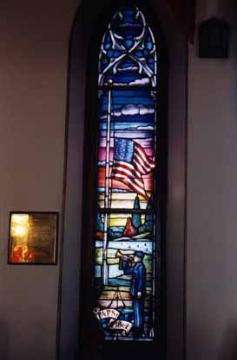
The Taps window at Ft. Monroe
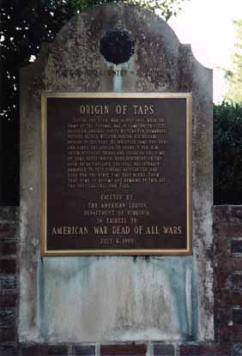
The Taps monument at Berkeley Plantation
Other stories of the origin of Taps exist. A popular, yet false, one is that of a Northern boy who was killed fighting for the south. His father, Robert Ellicombe, a Captain in the Union Army, came upon his son's body on the battlefield and found the notes to Taps in a pocket of the dead boy's Confederate uniform. He had the notes sounded at the boy's funeral. There is no evidence to back up the story or the existence of a Captain Ellicombe.
Why the name Taps? The call
of Tattoo was used in order to assemble soldiers for the last roll call of the
day. Tattoo may have originated during the Thirty Years War (1618-1648) or
during the wars of King William III during the 1690s. The word tattoo in this
usage is derived from the Dutch tap (tap or faucet) and toe (to cut off). When
it was time to cease drinking for the evening and return to the post, the
provost or Officer of the Day, accompanied by a sergeant and drummer, would go
through the town beating out the signal. As far as military regulations went,
there was a
prescribed roll call to be taken "at Taptoe time" to ensure that all the troops
had returned to their billets. It is possible that the word Tattoo became Taps.
Tattoo was also called Tap-toe and as is true with slang terms in the military,
it was shortened to Taps.
The other, and more likely,
explanation is that the name Taps was borrowed from a drummer's beat. The
beating of Tattoo by the drum corps would be followed by the Drummer of the
Guard beating three distinct drum taps at four count intervals for the military
evolution Extinguish Lights. During the American Civil War, Extinguish Lights
was the bugle call used as the final call of the day and as the name implies, it
was a signal to extinguish all fires and lights. Following the call, three
single drum strokes were beat at four-count intervals. This was known as the
"Drum Taps" or in common usage of
soldiers "The Taps" or "Taps." There are many references to the term "Taps"
before the war and during the conflict, before the bugle call we are all
familiar with came into existence. So the drum beat that followed Extinguish
Lights came to be called "Taps" by the common soldiers and when the new bugle
call was created in July 1862 to replace the more formal sounding Extinguish
Lights, (the one Butterfield disliked), the bugle call also came to be known as
"Taps."
The new bugle signal (also known as "Butterfield's Lullaby") is called "Taps" in common usage because it is used for the same purpose as the three drum taps. However the U.S. Army still called it Extinguish Lights and it did not officially change the name to Taps until 1891.
As soon as Taps was sounded that night in July 1862, words were put with the music. The first were, "Go To Sleep, Go to Sleep." As the years went on many more versions were created. There are no official words to the music but here are some of the more popular verses:
Day is done, gone the sun,
From the hills, from the lake,
From the sky.
All is well, safely rest,
God is nigh.
Fades the light; And afar
Goeth day, And the stars
Shineth bright,
Fare thee well; Day has gone,
Night is on.
Thanks and praise, For our days,
'Neath the sun, Neath the stars,
'Neath the sky,
As we go, This we know,
God is nigh.
As with many other customs, this solemn tradition continues today. Although Butterfield merely revised an earlier bugle call, his role in producing those twenty four notes gives him a place in the history of music as well as the history of war.
Information Courtesy of http://www.tapsbugler.com/24NotesExcerpt/Page1.html